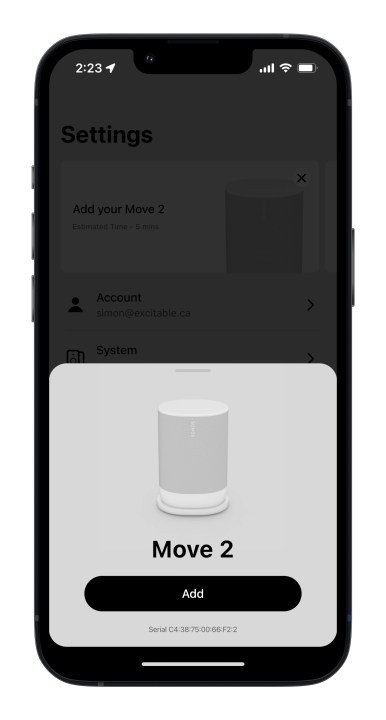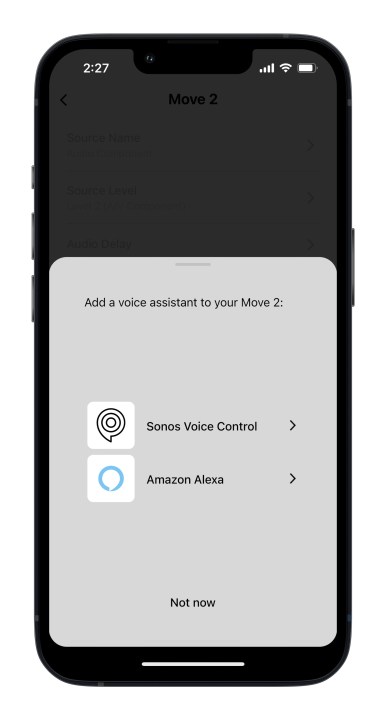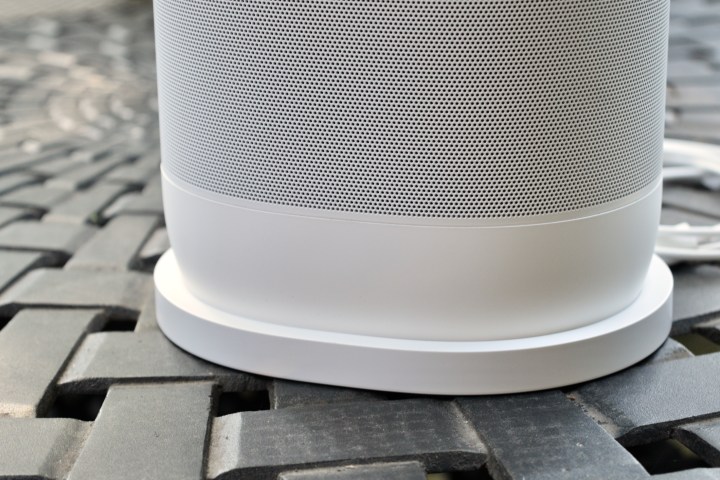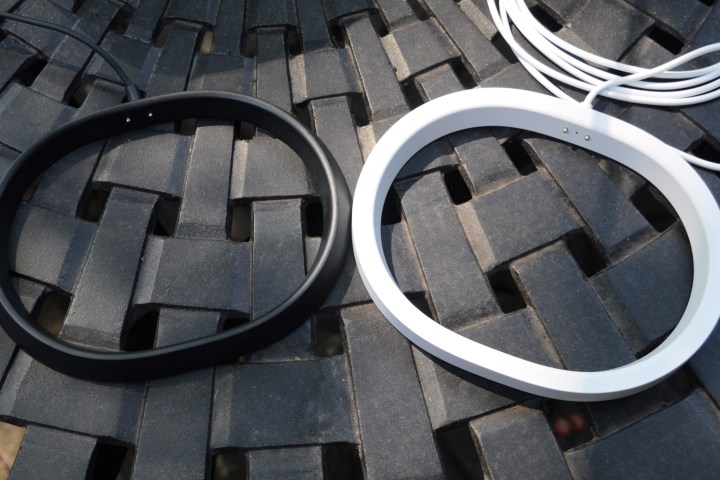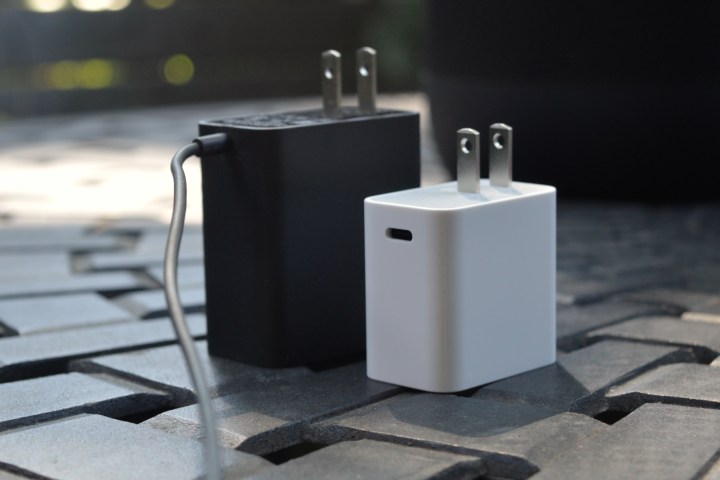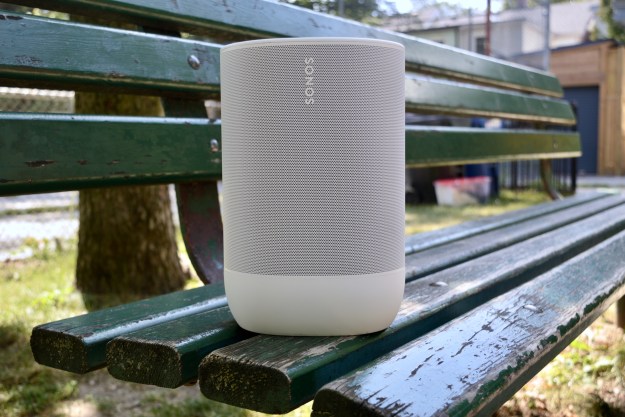
- Balanced and immersive sound
- 24-hour battery
- Analog line-in (with optional adapter)
- Charges your devices
- Awkward to carry
- No Google Assistant option
Despite being the company that almost single-handedly revolutionized how we listen to music in our homes, Sonos takes a very conservative, if-it-ain’t-broke-don’t-fix-it approach when evolving its wireless speakers. The new Sonos Move 2 is a perfect example. You’d be hard-pressed to tell the difference between it and its predecessor, the original Sonos Move, just by looking at them side by side (as you can see in some of the accompanying photos).
Sonos has preserved almost every curve, including the Move’s integrated carry handle. You can even swap the new and the old model from one speaker’s charging cradle to another. But under that nearly identical shell lies a surprising number of improvements, including stereo sound. The Move 2 may cost $50 more than the first-gen speaker, but these enhancements make that small extra investment seem like a no-brainer if you’re a Sonos fan looking to bring a powerful, yet portable smart speaker into your life.
Unless you’re also a Google fan. Yep, Sonos and Google remain at odds with each other, and the Move 2 pays the price.
I’ve been testing the Move 2 for about a week and here’s everything you need to know.
Sonos Move 2: design
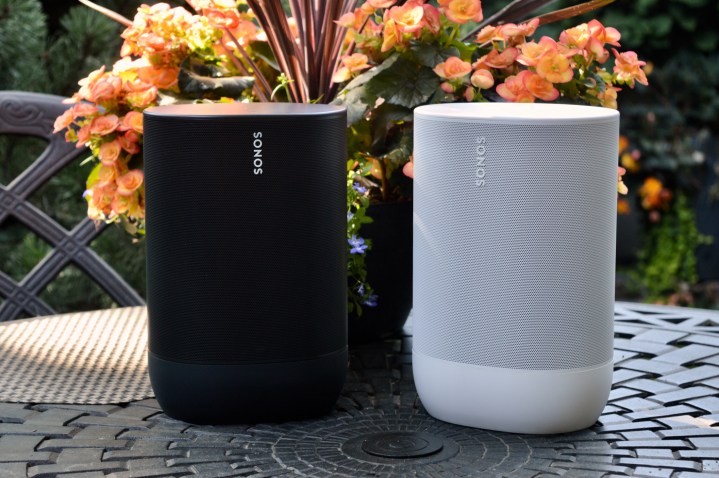
I just called the Move 2 portable, but the truth is that this speaker, like its predecessor, is more accurately described as luggable. It’s big. It weighs 6.6 pounds. And while its carry handle is convenient for moving the speaker from location to location, you won’t want to carry it very far. From your house to your car? No problem. A 15-minute walk to the beach? That’s going to be tiring. Good thing Sonos also makes the Roam, a truly portable speaker you can toss in a backpack.
Most folks I know who own the first-gen Move use it as their kitchen/patio speaker. They keep it on its charging cradle when in the kitchen, and then carry it outside to run on battery power when weather permits. Or they pack it in the car for road trips. It’s perfect for all of these scenarios, especially when you consider its IP56 protection, which will keep it from most types of water- and dust-related harm as long as you don’t let it go for a dunk in a pool. The rubberized base gives it a surprising amount of grip on most surfaces. And since most of the speaker’s mass is located near the base, it’s relatively tip-proof despite its height.

The Move 2 doesn’t change these fundamentals, but it does make them a bit better. The charging cradle is no longer permanently wired to its wall adapter, and the adapter itself is a lot smaller. With USB-C connections at both ends, you get more flexibility in how you use these two parts (you could choose to use the adapter to charge other devices), plus it makes replacing damaged components less costly. I’d have preferred if Sonos had given the adapter foldaway blades for even greater portability as Apple does with its MacBook bricks, but perhaps Sonos’ market research showed that it wasn’t a must-have.
The speaker also gets the same thoughtful touch controls that Sonos introduced on the Era 100 and Era 300. Volume control gets its own dedicated slider, so you no longer have to perform the first gen’s slightly awkward swiping gestures to track-skip forward and backward.
Sonos also has divided microphone control into two parts. There’s a touch control on the top of the speaker for quick muting of the mic, plus a hardware-based switch on the back panel that lets you physically disable the mic should you have concerns about privacy. I like that Sonos takes the issue of privacy seriously enough to have added this feature to the Move 2, but there’s an unfortunate side effect of using it: Sonos’ Automatic Trueplay room tuning function requires that the mic remain live, so you’ll need to make a choice between total privacy and convenience.
Sonos Move 2: setup, streaming, and software
Sonos fans don’t need me to tell them how great the company’s software is. But if you’re among the uninitiated, you’re in for a treat. Using the free Sonos app (iOS/Android/PC/Mac), setting up a Sonos speaker like the Move 2 is a breeze, whether it’s your first Sonos product or you’re adding it to an existing system.
I added it to an existing system and didn’t even have to tell the app I wanted to do so — the moment I sat the Move 2 on its powered charging cradle, the app prompted me to add it. Less than a minute later, it was ready to go.
Because the Sonos Move 2 is both a Wi-Fi- and Bluetooth-enabled speaker (more on how these work in a moment), you don’t need to use the app after the initial setup. Whether in Bluetooth mode or if you’re using Apple AirPlay 2 from an Apple device, you can stream music from your favorite source and never think about any other features — but you’ll be missing out if you do.
The Sonos app is not only the way you’ll adjust the Move 2’s settings like treble/bass, but it’s also an incredibly powerful tool for finding and playing music. You can add virtually any streaming music service, plus any personal music libraries you may have stored on a computer in your home, and search them all simultaneously. From there, you can build playlists that pull tracks from any of these sources and, if you have more than one Sonos speaker, choose to play the same music everywhere, or different selections in each location.
I’ve only seen one platform come anywhere close to Sonos’ level of software sophistication, but that platform — LinkPlay’s Wiim — doesn’t work with any wireless speakers yet.
Sonos Move 2: battery life and connections
- 1. Sonos Move 2 sitting on charging base.
- 2. Sonos Move (Gen 1) charging base in black and Sonos Move 2 charging base.
- 3. Sonos Move (Gen 1) charging adapter in black and Sonos Move 2 charging adapter.
The best parts of the Move 2’s design are invisible. Like the Era 100 and Era 300, the USB-C port on the back of the Move 2 is now a highly versatile interface. It can be used with two optional adapters. A 3.5mm line-in adapter ($19) lets you connect external analog audio sources like a turntable. And a combo adapter ($39) adds an Ethernet jack next to the line-in port in case you’d like to use a wired network connection. These are two great features the first Move lacked.
The 3.5mm adapter is particularly useful. Our 19-inch kitchen TV has lousy built-in speakers so we’ve always connected to an external speaker via the headphone jack. That gave us better sound, but at the cost of complexity and clutter. The external speaker needed to be turned on every time we wanted to watch TV, plus we still had a Sonos One speaker nearby so we could stream music. With the 3.5mm adapter, the Move 2 is able to seamlessly switch between being our TV speaker and our streaming speaker, automatically selecting the analog input as soon as it detects audio coming in on that port.
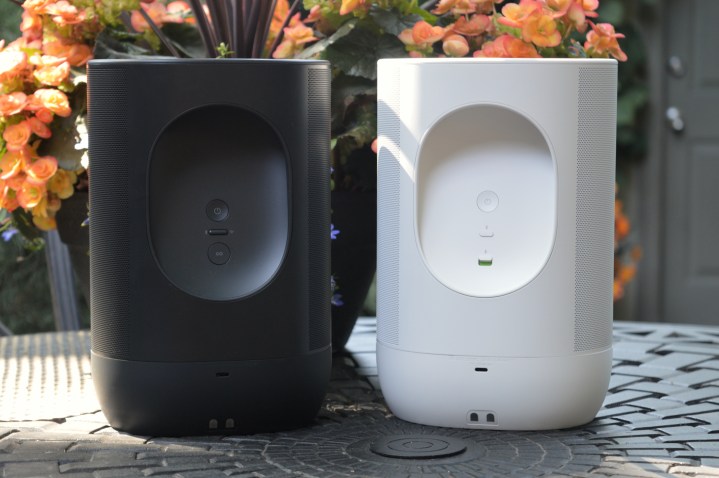
As before, you can use the USB-C port to charge the speaker when away from its cradle — although you’ll need a powerful USB-C Power Delivery (PD) charger — but now you can use the Move 2’s internal battery to charge your other devices.
Speaking of the Move 2’s battery, Sonos has more than doubled its playback time to up to 24 hours, versus 11 hours on the original Move. Its standby time is now much longer, too. The original Move was supposed to last 120 hours in standby mode, but it typically cuts out after about 24 hours. Once the Move 2 was fully charged, it happily stayed in standby mode for five days. Like the first-gen, the battery is a replaceable unit that can be accessed via hidden screws on the bottom of the speaker.
Unfortunately, there’s no visible indicator of remaining battery life on the speaker itself, and the app can only be used to see the battery level when connected to Wi-Fi. However, if you turn on Sonos Voice Control — I’ll cover voice assistants in a moment — some commands work even when you’re away from Wi-Fi, like “Hey Sonos, how’s my battery life?”
As I alluded to earlier, the Move 2 can maintain Wi-Fi and Bluetooth connections simultaneously — a big advantage over the first-gen Move, which needed to be manually switched between them. With both active, you can keep controlling the speaker’s settings via the Sonos app, even as you’re streaming over its Bluetooth connection. Even better, you can group the Move 2 with other Sonos speakers over Wi-Fi, letting you use that Bluetooth connection as the audio source for every speaker in your house. AirPlay 2 connections on Sonos have always worked this way, but since Android devices aren’t AirPlay compatible, it stopped short of being a handy feature for all Sonos users.
One option I wish Sonos would offer is the ability to use the Move 2 as a speakerphone when connected via Bluetooth.
Sonos Move 2: sound quality

The original Move has two things going for it in the sound department: rich, full bass — a trait it shares with the rest of the Sonos family — and a wider soundstage that lets you get the most out of the speaker when outdoors. Still, the first-gen doesn’t quite deliver on midrange clarity and definition as well as I would like, something that kept me from using it as my preferred Sonos speaker when inside.
The Move 2 — perhaps because of its dual angled tweeters — fills in much of the detail I felt its predecessor lacked. It also delivers more low-end bass, giving the Move 2 a more authoritative signature both inside and out.
This new sound signature takes the Move from being a great Sonos speaker for the outdoors to being a great Sonos speaker, period.
Sonos’ Auto Trueplay uses the speaker’s built-in mics to assess the acoustic properties of your space and tune the Move 2’s EQ accordingly so you get the best sound. It uses motion sensors to repeat the process every time it detects that you’ve moved the speaker. In most cases, I didn’t find that it made a huge difference, unlike Sonos’ standard iPhone-based Trueplay tuning, which I’ve used to significantly improve the sound of the company’s other wireless speakers.
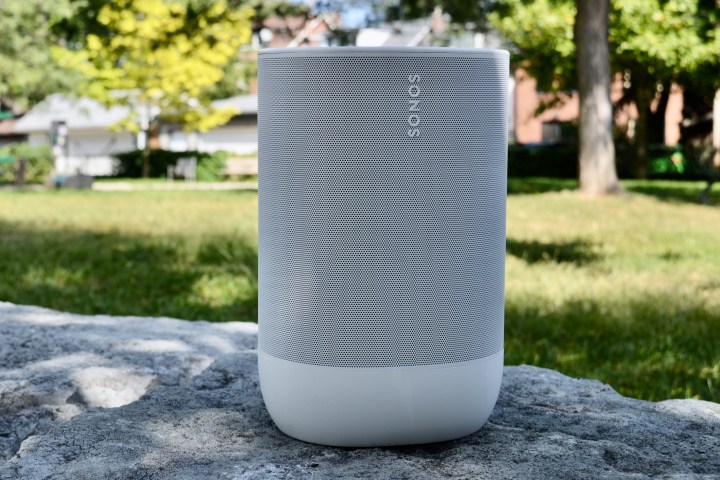
My advice is to simply leave it on (assuming you’re OK with the mics being used), but with one small caveat: On certain tracks, I noticed a sibilant quality to the vocals. Sibilance is that hiss-like sound that can accompany “s” sounds in speech, or it can show up as a kind of distortion on cymbals and other high-frequency sounds. After discussing the issue with Sonos, it may be related to Auto Trueplay — disabling the feature seemed to help.
Using the bass and treble adjustments within the Sonos app can dramatically alter the Move 2’s characteristics, so don’t be afraid to try those settings if you’re still not getting the sound you expect.
Sonos says those angled tweeters give the Move 2 true stereo sound and I’m not going to contradict that. However, unless you sit across from the Move 2, facing it head-on and perfectly centered, you likely won’t hear much of a left/right stereo effect. What you will get is an even wider soundstage than with the original Move. Inside, that creates a more immersive listening experience, while outdoors, it makes the Move 2 sound like a bigger speaker than its physical size would suggest.
Overall, it’s an improved performance over the original, which was pretty good to begin with.
Sonos Move 2: voice assistants
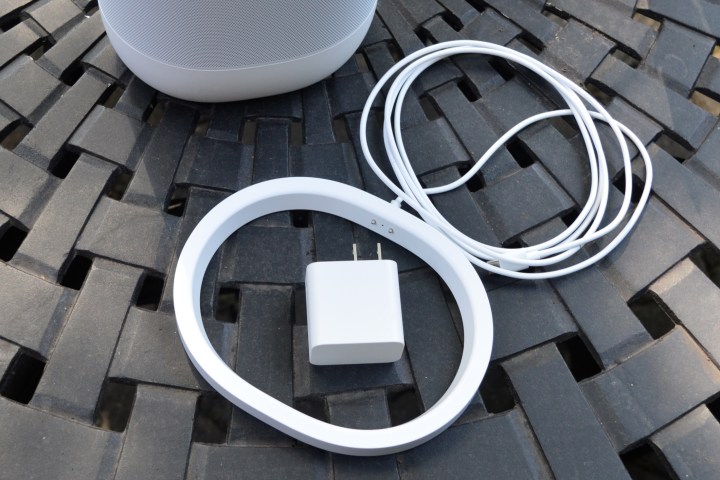
With the exception of its entry-level Ray soundbar, Sonos is a big believer in smart speaker functionality. You’ll find microphones built into nearly all of its speakers, and the company was one of the first to give its owners a choice over which voice assistant to install — Amazon Alexa or Google Assistant. In 2022, it even created its own in-house voice assistant, Sonos Voice Control, which uses an AI model to accurately mimic the sound of actor Giancarlo Esposito’s voice — it’s uncanny how real it sounds.
The original Sonos Move gives you the option to run any of these three voice assistants, but the Move 2 has been reduced to just Amazon Alexa and Sonos Voice Control. It’s the same constraint that was placed on the Era 100 and Era 300 when those products launched. At the time, Sonos claimed that Google had changed its hardware compatibility requirements for Google Assistant, resulting in a technical hurdle that couldn’t be overcome on the Era speakers.
It’s hard to know what to make of this explanation, especially in a world where JBL’s new Authentics smart speakers can run Amazon Alexa and Google Assistant simultaneously. It seems unlikely that, given Sonos’ long history with smart speaker tech, it can’t match JBL’s expertise. Sonos and Google’s acrimonious relationship is a more believable root cause.
Regardless, the Move 2 works well as an Amazon Alexa device, and being able to use Sonos Voice Control at the same time to issue Sonos-specific commands is a very handy bonus — no other smart speaker company offers anything nearly as powerful.
Sonos Move 2: should you buy it?
If you had been toying with the idea of buying the original Move, you now have even more reasons to pull the trigger on its successor. The Move 2 may cost a little bit more, but with better sound, a far longer battery life, and the ability to connect external devices, you’re getting a lot more value.
Already own a Move? The Move 2 could make for a nice upgrade, but you should probably bear a few things in mind. First, you can’t stereo-pair a first-gen Move and a Move 2. Sonos has always had a strict policy for stereo pairing — only identical products are allowed to do it. Second, the Move 2’s biggest benefits over the original are its longer battery life and its ability to connect to external devices. If neither of these matter to you, save your money. Finally, the absence of Google Assistant as a smart speaker option robs the Move 2 of some of its usefulness, especially if you’re already deeply invested in the Google Home ecosystem.

